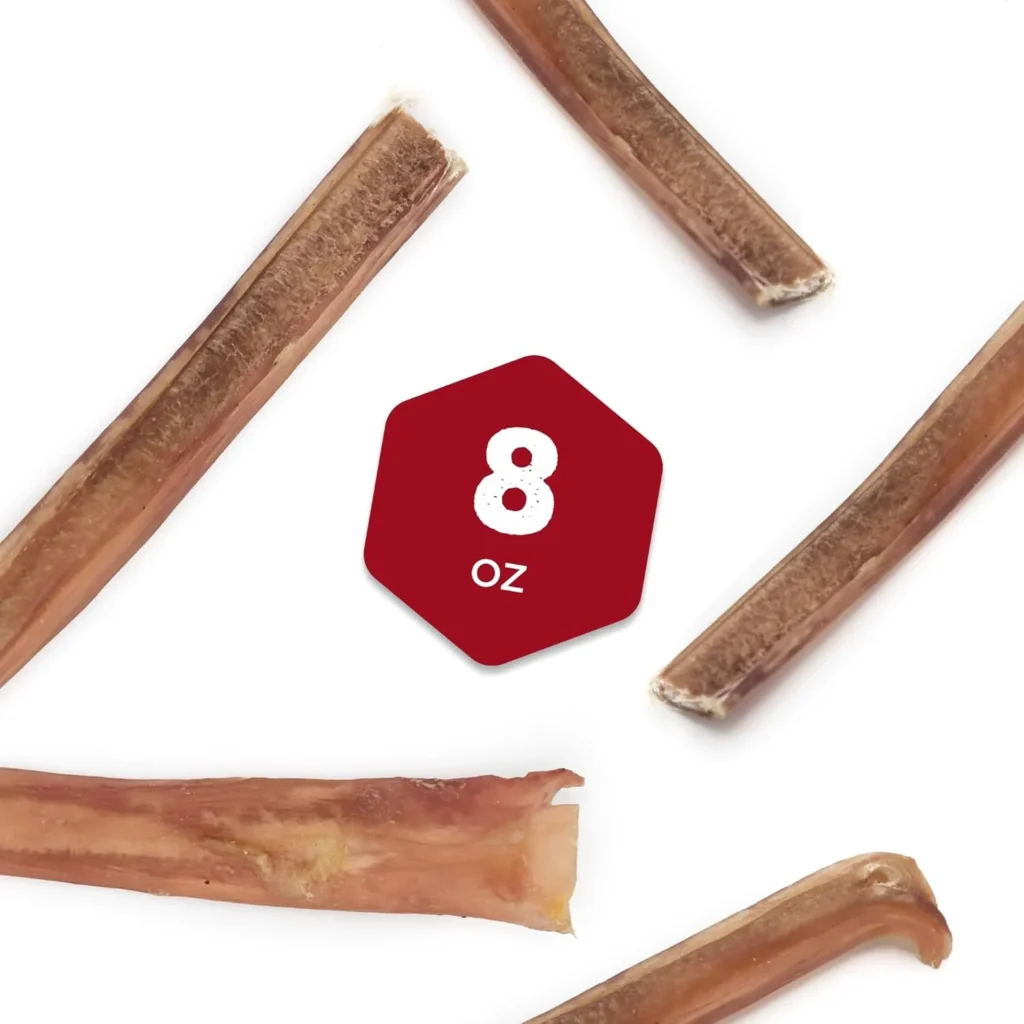Bully sticks are a popular and tasty chew treat for dogs, but many pet owners wonder if they’re truly safe. The short answer is yes, bully sticks can be safe for dogs when chosen and used appropriately. Made from 100% natural beef muscle, these treats are rich in protein and help promote dental health by reducing tartar buildup. However, it’s important to supervise your dog while they enjoy their bully stick to avoid choking hazards or overconsumption. As with any chew, size matters—always choose the right size bully stick for your dog’s breed and chewing habits. Additionally, opting for high-quality, odor-free bully sticks ensures you’re giving your dog a cleaner and safer treat.
What Are Bully Sticks?
The world of dog chews can be overwhelming. But bully sticks stand out because they are natural and durable. As a dog owner, it’s important to know what bully sticks are. This helps you make better choices for your pet’s treats.

The Origin and Manufacturing Process
Bully sticks are made from 100% beef pizzle, a muscle-rich part of the cow. The process includes cleaning, stretching, and drying the pizzle. This makes a tough chew. Some makers smoke or bake them to add flavor and texture.
The quality of bully sticks can differ a lot. It depends on who makes them and how. Good ones come from grass-fed cattle. They are processed without harmful additives or preservatives. This makes them a safe and healthy treat for dogs.
Nutritional Composition of Bully Sticks
Bully sticks are packed with protein and have very little fat. They also have important nutrients like calcium, phosphorus, and iron. The exact nutrients can change based on the maker and the product.
A typical bully stick is full of protein and has little fat. This makes it a great choice for a healthy, natural treat. But, always check the nutritional label. This ensures the treat fits your dog’s dietary needs.
Are Bully Sticks Safe for Dogs?
The short answer is yes,As a dog owner, you might wonder if bully sticks are safe for your pet. The safety of bully sticks depends on several factors. These include their general safety, what regulatory bodies say, and what vets think.
General Safety Profile
Bully sticks are made from natural beef pizzle. They are tough and tasty. They are safer than rawhide chews because they don’t usually upset a dog’s stomach if eaten. But, like any treat, they can still pose some risks.
One big worry is choking or blockage if a dog swallows a big piece. Always watch your dog when they eat these sticks. Make sure the stick is the right size for your dog.

FDA and Veterinary Perspectives
The FDA and vets have good things to say about bully sticks. The FDA hasn’t made specific rules for them. But, they talk about the importance of how they are made and where they come from.
Vets think bully sticks are okay for dogs if used right. They say it’s key to watch how your dog acts and feels while eating them.
| Safety Aspect | Description | Recommendation |
|---|---|---|
| Choking Hazard | Risk of choking if large pieces are swallowed | Supervise consumption, choose appropriate size |
| Digestive Issues | Potential for digestive upset if ingested | Monitor for signs of digestive issues |
| Manufacturing Quality | Risk of contamination or poor quality | Choose reputable manufacturers |
Potential Benefits of Bully Sticks
As a dog owner, you might wonder about the benefits of bully sticks for your pet. Bully sticks are known as one of the best chews for dogs because they are durable and nutritious. They can improve your dog’s health and happiness.
Dental Health Advantages
Bully sticks are great for your dog’s teeth. Chewing on them helps remove plaque and tartar, which can prevent dental problems. It also strengthens your dog’s jaw muscles.
Using bully sticks regularly can make your dog’s gums healthier and their breath fresher. It’s important to choose the right size of bully stick for your dog to get the most benefits.
Mental Stimulation and Behavioral Benefits
Bully sticks also keep dogs mentally active. Chewing on them can calm and satisfy your dog, reducing stress and anxiety. They are especially helpful for dogs with behavioral issues caused by boredom or too much energy.
By giving your dog a bully stick, you can stop them from chewing on furniture or other things they shouldn’t. This makes your home more peaceful and your dog happier.
Nutritional Value
Bully sticks are not just fun but also nutritious. They are made from high-protein ingredients and are low in fat. They are a healthy snack for dogs when chosen according to pet snack guidelines.
It’s important to pick bully sticks from trusted manufacturers. This ensures they are safe and keep their nutritional value.
Potential Risks and Concerns
Bully sticks can be a great treat for dogs, but it’s important to know the risks. They can be nutritious and fun for your pet.
One big worry is choking or blockages. Bully sticks can be dangerous if they’re too big or break into small pieces. These can get stuck in your dog’s throat.
Choking and Obstruction Hazards
The size and shape of bully sticks matter a lot. Choose sticks that fit your dog’s size and age. Watching your dog while they chew can also help avoid problems.
Another risk is bacterial contamination. Bully sticks can carry bacteria if they’re not made right.
Bacterial Contamination Risks
To avoid bacterial risks, get bully sticks from trusted makers. Make sure they test for Salmonella and E. coli.
| Risk Factor | Prevention Measure | Benefit |
|---|---|---|
| Choking Hazard | Choose the right size, supervise | Reduced risk of obstruction |
| Bacterial Contamination | Source from reputable manufacturers | Lower risk of bacterial infection |
| Caloric Content | Monitor calorie intake, balance diet | Maintained healthy weight |
Bully sticks can also affect weight if eaten too much. They’re nutritious but can cause weight gain if not balanced.
Caloric Content and Weight Management Issues
Keep an eye on your dog’s calories and make sure they exercise. It’s key to balance bully sticks with other foods.
Knowing these risks and how to avoid them can make bully sticks a safe and fun treat for your dog.
Common Myths and Misconceptions
If you’re thinking about giving your dog bully sticks, it’s key to know the truth. Many people worry about their safety and benefits because of false information online.
Bully sticks are a favorite natural treat for dogs, but they’ve got their share of myths. Let’s clear up some common safety worries and myths about bully sticks.
Addressing Safety Concerns
Many worry about the safety of bully sticks. They might think they’re bad because of where they come from or how they’re made. But, reputable manufacturers make sure their products are safe for dogs to eat.
- Bully sticks are made from high-protein, easy-to-digest ingredients.
- They are a natural alternative to fake dog chews.
- Most bully sticks come from grass-fed, free-range cattle.
To ease worries, pick bully sticks from makers who follow strict quality control measures. This includes handling, storing, and packaging to avoid bacterial contamination.
Separating Facts from Fiction
Some myths say bully sticks are low-quality or dangerous. But, the truth is that high-quality bully sticks are 100% beef pizzle, with no additives or preservatives.
Here are some facts that clear up common myths:
- Bully sticks are a nutritious and healthy treat option when chosen right.
- They are long-lasting, making them great for keeping your dog busy.
- Good brands make sure their bully sticks are free from harmful chemicals and contaminants.
Knowing the truth and being aware of myths helps you decide if bully sticks are good for your dog. Always talk to your vet if you have diet or health concerns for your dog.
How to Choose High-Quality Bully Sticks
Choosing the right bully sticks can be tough with so many options. You want the best for your dog, ensuring they get the nutrients they need. It’s also important to consider the impact on the environment and animal welfare.
When looking at sourcing and manufacturing standards, it’s key to find reliable suppliers. They should use high-quality production methods and source from trusted farms. Make sure the manufacturing facilities have strict quality control.
Sourcing and Manufacturing Standards
Understanding where and how bully sticks are made is crucial. Look for ones from grass-fed, free-range cattle. The making process should be simple, with no added ingredients. Choose manufacturers who are open about their methods.
| Manufacturing Standard | Description | Importance |
|---|---|---|
| Sourcing | Grass-fed, free-range cattle | High |
| Processing | Minimal processing, no additives | High |
| Quality Control | Regular inspections and testing | High |
Ethical and Sustainable Options
Many dog owners care about the ethics and environmental impact of their pet’s food. When choosing bully sticks, look at their sustainability. Eco-friendly packaging and high animal welfare standards are important.
Reading Labels and Avoiding Additives
It’s vital to understand pet snack guidelines. Always check the labels to ensure the bully sticks are free from additives. Choose products labeled as natural or organic with few ingredients.
- Check for certifications like USDA Organic or Non-GMO.
- Avoid products with preservatives or artificial flavorings.
- Opt for products with transparent labeling regarding ingredients and sourcing.
By considering these factors and following pet snack guidelines, you can find the best chews for your dog. These chews will meet their nutritional needs and match your values.
Safe Usage Guidelines
Using bully sticks safely is key to keeping your dog happy and healthy. A few simple steps can help avoid risks and make bully sticks a great treat for your pet.
Choosing the Right Size
Picking the right size bully stick is very important. A too-small stick can choke your dog, while a too-large one might not get eaten before it becomes a health risk. Here’s how to pick the right size:
- For small dogs, choose shorter and thinner bully sticks.
- For larger dogs, longer and thicker bully sticks are more appropriate.
- Consider your dog’s chewing style: aggressive chewers may require larger, more durable bully sticks.
Supervision Best Practices
Watching your dog when they chew on a bully stick is crucial for their safety. Here are some tips:
- Always supervise your dog when giving them a bully stick.
- Watch for signs of choking or obstruction, such as gagging or difficulty breathing.
- If your dog starts to chew aggressively or tries to swallow large pieces, intervene promptly.
Proper Storage and Handling
Storing and handling bully sticks correctly is important for their quality and safety. Here are some tips:
- Store bully sticks in a cool, dry place to prevent bacterial growth.
- Keep them in an airtight container to maintain freshness and prevent contamination.
- Check the expiration or “best by” date on the packaging and use the oldest products first.
By following these guidelines, you can make sure bully sticks are a safe and fun treat for your dog. Remember, every dog is unique, so adjust your approach to fit your pet’s needs and preferences.
Introducing Bully Sticks to Your Dog
Introducing bully sticks to your dog needs a careful approach. This ensures they can enjoy the benefits without harm. Benefits include better canine dental health.
Introducing bully sticks involves several steps. It’s more than just giving a new chew toy. It’s about keeping your dog safe and healthy.
First-Time Tips and Monitoring
Start with a small bully stick or a sample size for the first time. Watch your dog closely for any signs of intolerance or allergic reactions.
- Begin with short sessions to observe how your dog reacts to the bully stick.
- Supervise your dog to prevent choking hazards or obstruction.
- Check for any signs of digestive upset, such as diarrhea or vomiting.
Here’s a simple table to help you monitor your dog’s reaction to bully sticks:
| Observation | Normal Reaction | Abnormal Reaction |
|---|---|---|
| Chewing Behavior | Active chewing, interest in the bully stick | Lack of interest, or aggressive behavior towards the bully stick |
| Digestive Health | No changes in stool or vomiting | Diarrhea, vomiting, or loss of appetite |
Signs Your Dog May Not Tolerate Bully Sticks
While bully sticks are generally safe, some dogs may not tolerate them well. It’s important to recognize signs of intolerance early.
Some common signs include:
- Gastrointestinal upset, such as diarrhea or vomiting.
- Lack of interest or refusal to chew on the bully stick.
- Aggressive behavior when given a bully stick.
If you notice these signs, talk to your vet. They can advise on whether to keep using bully sticks or find other chews.
Comparing Bully Sticks to Other Dog Chews
Choosing the right chews for your dog is important. It’s key to know the differences between bully sticks and other options. As a dog owner, you might be looking at various chews for your pet. Comparing their features can help you make a good choice.
Rawhide Alternatives
Rawhide chews have been popular, but safety concerns have led to looking for alternatives. Bully sticks are made from natural, high-protein ingredients that are easier to digest. They are also safer because they are less likely to cause blockages or splintering.
But, not all rawhide alternatives are safe. Some may have additives or be processed in ways that are not safe. When choosing between bully sticks and other alternatives, look at the manufacturing process and ingredients. This ensures you get a high-quality product.
Antlers, Bones, and Other Natural Chews
Antlers, bones, and other natural chews are durable and long-lasting. They provide entertainment and dental benefits for dogs. But, they can be hard and might cause dental fractures if not chosen carefully.
Bully sticks are softer and more pliable, which reduces the risk of dental damage. They are also more digestible than some natural chews. Still, it’s important to supervise to prevent choking hazards.
- Antlers are durable and long-lasting but can be hard on teeth.
- Bones can be a natural source of calcium but may splinter.
- Bully sticks offer a softer, more digestible alternative.
Synthetic Chew Toys
Synthetic chew toys, made from materials like rubber or nylon, have their own benefits and drawbacks. They are often durable and can withstand aggressive chewing. But, they may not offer the same dental benefits or satisfaction as natural chews.
Bully sticks, being natural, can provide a more satisfying chewing experience for dogs. They might be more appealing to some pets. However, synthetic chew toys are good for dogs with sensitivities or allergies to certain proteins or ingredients found in natural chews.
The choice between bully sticks and other chews depends on your dog’s needs, preferences, and health. By considering the pros and cons of each option, you can choose what’s best for your dog’s health and happiness.
Special Considerations for Different Dogs
The safety and fun of bully sticks for your dog depend on several things. These include their age, dental health, and how sensitive their stomach is.
When thinking about bully sticks for your dog, remember their life stage and health. Puppies, senior dogs, and dogs with health problems need special care to stay safe and happy.
Puppies and Senior Dogs
Puppies grow fast and their stomachs are sensitive. It’s best to start them on bully sticks when they’re old enough and watch them closely. Senior dogs might have dental or stomach issues to think about.
For puppies and senior dogs, pick bully sticks that are easy to digest and won’t hurt their teeth or gums. Always watch how your dog reacts to new treats and make changes if needed.
| Life Stage | Considerations | Recommendations |
|---|---|---|
| Puppies | Sensitive digestion, dental development | Introduce gradually, supervise closely |
| Senior Dogs | Dental issues, digestive sensitivities | Choose gentle, easy-to-digest options |
Dogs with Dental Issues or Sensitive Digestion
Dogs with dental or stomach problems need extra care with bully sticks. For dental issues, softer bully sticks or dental health ones are better.
For sensitive stomachs, pick bully sticks made from good, easy-to-digest ingredients. Always check the labels and avoid treats with additives or preservatives.
By thinking about your dog’s needs and picking the right bully sticks, you can make sure they have a safe and fun time.
Conclusion: Making an Informed Decision About Bully Sticks
As a dog owner, keeping your pet safe and happy is key. Understanding bully stick safety is important. We’ve looked at their safety, including where they come from, what’s in them, and possible dangers.
Before using bully sticks, think about the good and bad. Look at your dog’s needs, age, and health. Puppies, senior dogs, and those with dental or digestive issues need extra care.
Choosing the right bully sticks and using them safely can help. The safety of bully sticks for dogs depends on how you use them. Being informed helps you choose what’s best for your dog’s health and happiness.





